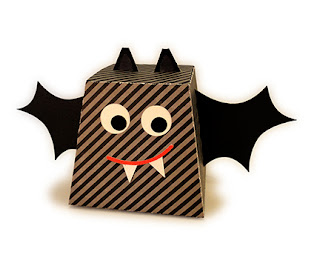With wings folded, timid bat
barely peeks over the top.
Open the wings to reveal "HALLOWEEN" greeting,
and
penny-slide the little guy's head up,
and he is ready with a grin.
A7 (5x7)
size range when folded.
Includes a letters positioning guide to cut and use.
Multiple body and head/neck slider layers make card sturdy.
ASSEMBLY: 1. Identify and cut the shapes:
A main bat "front" body with wing (choose
a two-sided paper such as a solid.
NOTE that the shape is shown backside up)
B left wing
C left & right outer wing accents
D feet E "HALLOWEEN" letters
F letter placement guide
G body slot build up layers (3)
H back body with slider slot I penny cover
J back head K back head reinforcement
L head build up layers (5)
M front head with eye and mouth accents
N head liner (mouth, ears show thru)
O face accents (eye, under-eye, fangs, tongue)
2. Prepare the left wing by folding the inner flange
back (mountain fold).
3. Position and attach wing to main body front
with tab flange behind the body edge.
NOTE the body shapes are shown
back side up in steps 2-4.)
at the backside lower portion of the
back body.
high position when opened.
Fold wings across to prepare to send card.
You may wish to use a temp adhesive dot
on the underside of the top wing to
help the card stay in the closed position.
A main bat "front" body with wing (choose
a two-sided paper such as a solid.
NOTE that the shape is shown backside up)
B left wing
C left & right outer wing accents
D feet E "HALLOWEEN" letters
F letter placement guide
G body slot build up layers (3)
H back body with slider slot I penny cover
J back head K back head reinforcement
L head build up layers (5)
M front head with eye and mouth accents
N head liner (mouth, ears show thru)
O face accents (eye, under-eye, fangs, tongue)
back (mountain fold).
3. Position and attach wing to main body front
with tab flange behind the body edge.
NOTE the body shapes are shown
back side up in steps 2-4.)
4. Position and attach the letters to the face side
of the main body unit, using the optional
placement guide, aligned (but NOT glued)
along the top of the body shape as shown.
The letters can be glued in place, while the
guide is simply laying over the wing shape,
then the guide is removed . . .
. . . to leave just the letters in place.
NOTE that letters placement must avoid
the wing folds (placement guide ensures this spacing).
5. Position and attach the wing edge accents
on the FACE side of the wings, with edges lined up.
6. Prepare the build up shapes by gluing together
the following shapes, taking care to line up edges
as accurately as possible:
a) head and head reinforcement
b) body build up - 3 shapes
c) upper head - 5 shapes
NOTE it may be helpful to place the
assembled units under flat weights during
the drying process to help avoid warping -
here and throughout the steps involving
the build up shapes.
7. Position and attach the body build up shapeat the backside lower portion of the
back body.
Position the back body unit behind the
body/wings front unit, lining up the edges
the match as accurately as possible.
8. Prepare the front head by positioning
and attaching
the layered eye outline & eye base,
eye pupil and contrast under shape,
mouth outline as shown.
9. Position and attach the head front unit over
the contrast liner that will shown through
ears and mouth cutouts.
10. Position the fang teeth below the
mouth outline evenly spaced in from
mouth sides, and the tongue along the lower edge.
11. Identify the position guide dashed circle
for the foam "stem" of the slider action
at the center of the back head unit.
(NOTE since the paper used for this model
is colored and textured, the markings were
easier to see on the backside which is shown here.)
Trim a foam circle to match the guide,
or use the "slider stem template".
The foam circle must fit inside the slot opening
on the back body, relatively snug, but with
no impeding interference.
Position and attach securely on the
face side of the back head.
12. Position the "inner" head build up layers on
the backside of the front head/face unit.
13. Position the back head unit over the
backside of the build up and attach in place
to the build up ONLY.
Bottom remains free so that it can slide over
the body build up.
This image shows the same step from the
front of the assembly.
13. Begin final assembly of the slider by
inserting the head back stem between the
back body and the front body/wings . . .
. . . and slide into place until the foam circle
can fit into the back body slot as shown.
14. Position and attach (hot glue or other
similar quick grab, secure adhesive)
penny or equivalent size metal washer
on the foam circle.
15. Position and attach the penny cover.
To close the card with the "shy" bat position,
slide the head down to lowest position,
and close wings.
Use penny to slide the head up to thehigh position when opened.
Fold wings across to prepare to send card.
You may wish to use a temp adhesive dot
on the underside of the top wing to
help the card stay in the closed position.









































































